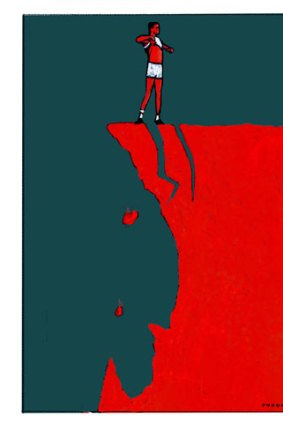By Matthew Klugman and Gary Osmond
It seemed like an awful parody. Two Collingwood barrackers abusing an opposition player simply because he was indigenous. The shock and outrage were immediate. This isn't supposed to happen, not in 2013, not since Nicky Winmar and Michael Long drove a transformation of Australian rules football.
Chris Yarran - the Aboriginal footballer being vilified on this occasion during the latest Collingwood versus Carlton match - didn't hear the abuse. There was no replay, therefore, of Winmar's compelling response to the abuse of some Collingwood supporters in April 1993.

Illustration: Andrew Dyson
It's 20 years today since that moment. Since Nicky Winmar reacted to yet another venomous torrent by lifting his jumper, pointing to his skin and saying the words that reverberated around Australia, ''I'm black and I'm proud to be black.''
Although the TV cameras missed the moment, two young photographers - Wayne Ludbey and John Feder - captured it on film. The resultant pictures have become iconic. Winmar stands tall, gazing defiantly at the crowd, his flawless physique exposed, the colour of his skin a statement to all. His gesture is at once public and intimate, a pronouncement of pride in the form of an open challenge.
Racist abuse was part of footy culture then. Winmar and his indigenous teammate Gilbert McAdam were routinely vilified that day, and many others, by opposing players and spectators alike. The term ''black'' was used as if it were a grave insult.
A week later, then Collingwood president Allan McAlister unwittingly gave an insight into the underlying dynamics of the abuse.
He wanted to assure people that the Magpies did not have an issue with indigenous Australians, but then added the following proviso: ''As long as they conduct themselves like white people, well, off the field, everyone will admire and respect … As long as they conduct themselves like human beings, they will be all right. That's the key.''
McAlister was giving voice to long-discredited but still active assumptions of racial hierarchies. Assumptions that had their roots in racialised science which saw white men as the pinnacle of evolution and believed indigenous Australians were the remnants of an inferior, dying race. It was such continuing, inchoate beliefs which made black a term of disparagement.
But by 1993 things seemed to be changing. It was the International Year of Indigenous Peoples, a year launched by prime minister Paul Keating's Redfern Speech and bolstered by the High Court's Mabo decision and the success of Yothu Yindi's hit single Treaty. Race was in the news internationally as well. South Africa was on the cusp of great change, while a few hours before Winmar made his gesture the Los Angeles police who assaulted Rodney King were found guilty by a civil court.
The racism that had long been a part of footy culture now seemed out of place. The compelling pictures of Winmar pointing with pride to his skin were widely acclaimed, while the taunts he and others routinely faced sparked outrage around much of Australia.
The Australian Football League responded by saying it would make on-field racial abuse a punishable offence. Two years later, in 1995, Essendon's Michael Long made the AFL honour its word by calling for action after being abused by Collingwood's Damian Monkhorst.
The AFL responded by creating Rule 30, the first Australian sporting law prohibiting racial vilification. The AFL has been justifiably celebrated for this rule, and regularly proclaims its leadership in the battle against racism. It showcases an ''Indigenous Round'' each year with a Dreamtime at the 'G game and supports the associated Long Walk. On-field racial abuse is rare and incidents of racial vilification by spectators are isolated rather than common. Yet significant questions remain concerning racism in footy.
Aboriginal players are still routinely spoken of in terms of their magical abilities and special talents in ways that ignore the countless hours they have spent honing their skills.
This might seem harmless, but it points to continuing assumptions of racial difference which emphasise natural ability and underplay work, intellect and culture.
The disturbing aspect of such assumptions was made apparent in the assertions by Paul Roos and James Hird that indigenous players lacked the endurance of other (white) players - a claim made all the more bizarre by the elite stamina of players such as Adam Goodes. Further damaging presumptions of difference can be found in the reporting of Liam Jurrah and the troubles of some other indigenous players.
The indigenous studies scholar Barry Judd refers to the current AFL culture as one of ''enlightened racism''. Racial abuse is not tolerated, but many racial assumptions continue to go unquestioned, while the lack of indigenous coaches and administrators is striking.
Waleed Aly has argued that the pervasive unchallenged racist assumptions of mainstream Australia are far more concerning than the racist outbursts of goons. The same might be said with regards to the AFL.
The image of Winmar pointing with pride to his dark skin continues to be shown over and over again, turning up in newspapers, posters, and street art. Its power lies not only in the effect it had, but in its compelling call for change that is yet to come. The horrid shouts of a few deluded fans will be quickly dealt with. But damaging assumptions of inferiority remain.
Matthew Klugman (Victoria University) and Gary Osmond (University of Queensland) have a forthcoming book and an exhibition at the National Sports Museum (MCG) on the history and impact of the Nicky Winmar image.